Learning how to build a chatbot can aid businesses in creating a sophisticated AI-driven virtual assistant to help with various tasks. More comprehensive chatbots can use this feature to determine the quality and level of resources used per instance. These bots can also be outfitted to respond with a specific "personality," which can benefit companies looking for a friendlier or more professional approach.
At Aloa, our team is dedicated to advancing software development in as many fields and industries as possible. With our expertise in artificial intelligence and machine learning in various businesses and sectors, we ensure to partner each client with a company that specializes in building chatbots to maximize productivity.
In this blog, we will discuss what a chatbot is and the different types you can develop. We will also go into detail on how to build a chatbot, whether it's for personal use or for a larger corporation. Additionally, we’ll explore all considerations and essential features to ensure that the bot operates as intended.
Let’s begin!
What is a Chatbot?
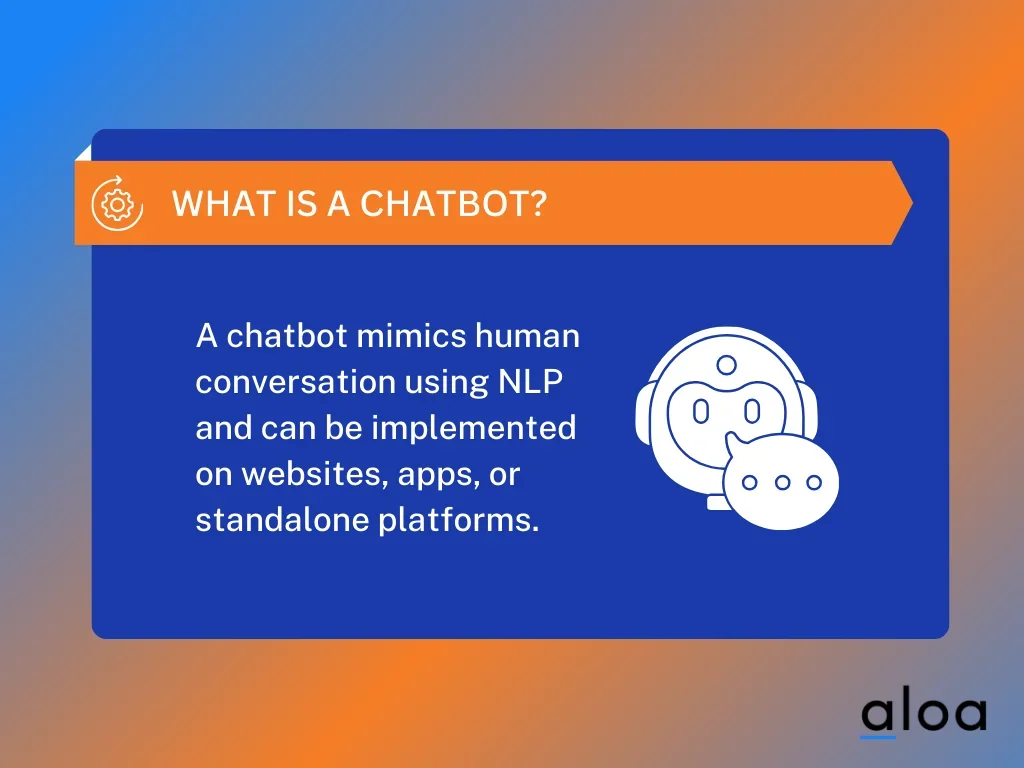
A chatbot is a computer program designed to simulate conversation with human users. This system uses Natural Language Processing (NLP) to understand and interpret user inputs and respond in a way that mimics human interactions based on the inputs or resources available.
Chatbots can be implemented on various platforms, such as websites, messaging apps, or standalone applications. Companies can also utilize a chatbot to integrate a personalized online help desk that caters to specific questions or redirects them to specific pages within their website.
Types of Chatbots
Chatbots are capable of communicating information at a sophisticated level. However, this type of software still requires guidance and preliminary testing before it can present itself as intended by the developer. Different types of chatbots can vary in use cases, with each system offering different benefits and features that can help narrow down its communication capabilities.
Here are some of the most common types of chatbots:
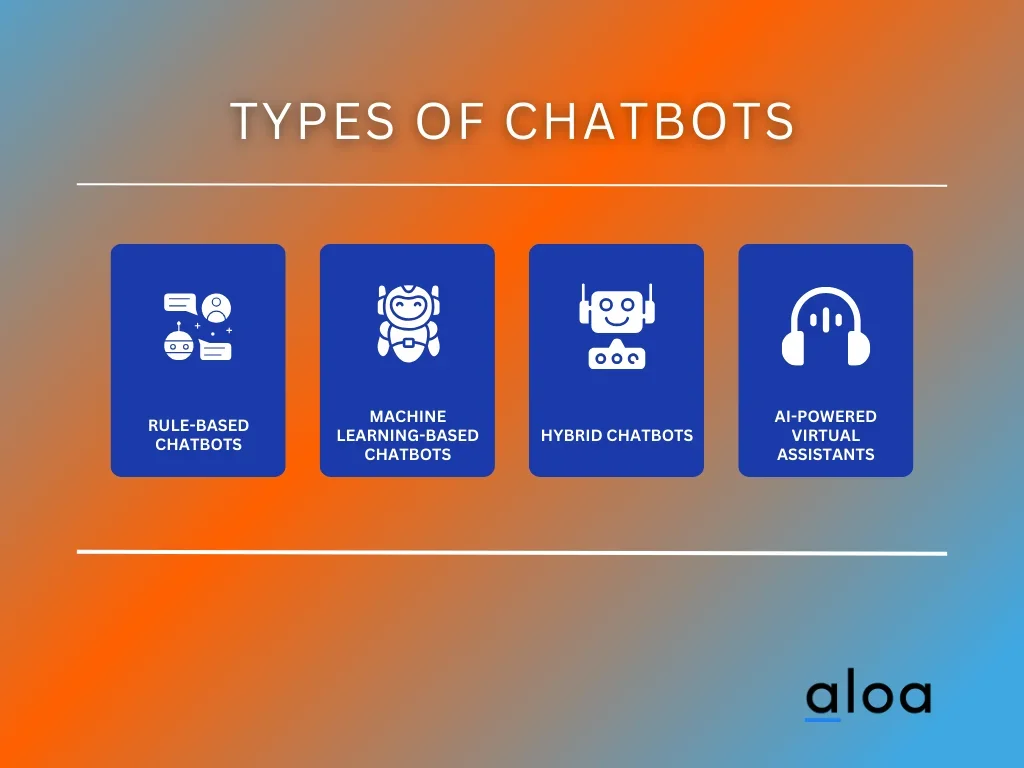
1. Rule-Based Chatbots
The most straightforward formation that a chatbot can follow is by setting predefined rules that allow specific responses based on the information provided. The rule-based system follows a dedicated decision-tree logic that calculates the proper response based on specific keywords or patterns through user input.
The simplicity of rule-based chatbots is a great beginner's guide to understanding the potential of learning how to build a chatbot. Websites and businesses considering a simplified approach to answering basic human questions can also use this cost-effective and basic structure reliably to answer basic queries.
2. Machine Learning-Based Chatbots
Machine Learning (MI) algorithms can help progress the development of a chatbot over extended usage. By feeding past interactions and user feedback, a bot can use this information to enhance its ability to understand and respond to user queries based on human responses. Some well-developed chatbots can even integrate everyday slang or trending words as part of their "personality" responses.
This software system can help chatbots become more adaptable to new scenarios, removing the need to build a chatbot that requires constant developer interjection. The ability to comprehend unstructured conversations can also be a significant benefit to keeping the conversation consistent through large texts.
3. Hybrid Chatbots
As both hardware and software technology continue to reach new developments, integrating a hybrid approach of machine learning, AI, and rule-based algorithms becomes essential to creating sophisticated systems. Learning how to build a chatbot through a hybrid system provides the best of both worlds by balancing structured responses while being adaptive to comprehend common human errors or slang.
These types of chatbots typically start with a comprehensive rule set while also integrating machine learning and artificial intelligence capabilities to take complex or evolving situations as part of their potential responses.
4. AI-Powered Virtual Assistants
One of the most significant contributors to the advancement of chatbots is the development and implementation of complex artificial intelligence. The ability to deeply understand context and learn directly from user behavior can provide personalized responses automatically. Each response can also calculate personal information or emotion based on the context of each message.
AI-powered virtual assistant tools can also perform advanced tasks beyond basic conversation, such as setting reminders, making reservations, or retrieving information from available databases.
How to Build a Chatbot
Learning how to build a chatbot takes precise coding and implementation to ensure that it functions properly based on the specifications set. With machine learning and artificial intelligence capabilities, chatbots can easily become more comprehensive with extensive usage, revolutionizing its use cases for various industries.
Here is a comprehensive guide on how to build your own chatbot:
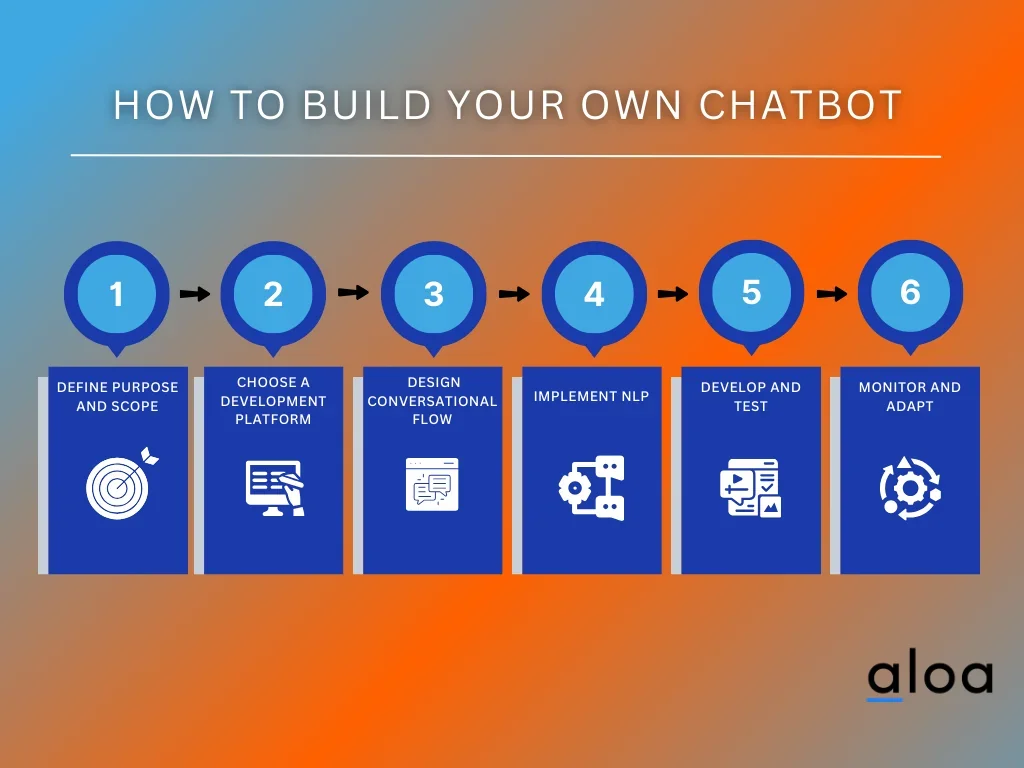
Step 1: Define Purpose and Scope
Before writing the code required to create a chatbot, it's important to clearly outline the goals and objectives first. Determining the scope of your chatbot's capabilities and the specific tasks it can handle will help software developers set limitations while developing the bot's "personality" and initial responses.
Here’s how to start defining the purpose and scope of your chatbot:
- Identify the Target Audience: Filtering your target audience allows for more opportunities to capitalize on the needs of that group. This creates a system that is more well-equipped to communicate more naturally to a select group of individuals.
- Figure Out the Target Goal: Chatbots are designed to act and respond in a certain way. Figuring out the final goal of the chatbot allows for better handling and steering of the conversation while preventing the topic to branch out unexpectedly.
- Detail the Chatbot Flow: Will it guide users through a process? Resolve a complaint? Provide dynamic information? Map out key dialog branches to guide you with defining its key purpose to users.
Step 2: Choose a Development Platform
Choosing between different chatbot development platforms can help integrate features, restrictions, and components based on the regulations and limitations of your software. Custom websites or businesses can implement hard rules to limit the type of responses that a chatbot can reply to its users. Social media platforms such as Facebook Messenger, Slack, or Discord are examples that contain specific rules against bot misuse.
Utilizing different chatbot development frameworks and tools such as Microsoft Bot Framework, Dialogflow, or Rasa allows for integration features to various APIs and software. This is way helpful when setting meetings, sending an email, or improving the workflow between groups.
Step 3: Design Conversational Flow
The central concept of a functioning chatbot is how well it is planned to deal with conversational flows and user intent. Identifying the possible key user inputs and defining the appropriate responses of your chatbot can help establish the foundation of creating an engaging personality for each conversation.
Conversation flow can play out depending on the type of chatbot created. Rule-based chatbots will require more detailed responses, while machine learning and AI-powered bots can slowly gain a base of their intended personality through constant back-and-forth communication between testing and user feedback.
Here are some ways to effectively direct the conversational flow design of a chatbot:
- Analyze User Input: Training a chatbot to understand common user inputs can help distinguish the responses that it can provide. Analyze the most common queries and writing patterns of various users to create a more natural direction towards the final goal.
- Intent Mapping: One of the main targets of directing the conversational flow design is to have the intent mapped out to end results. Having a chatbot be derailed due to uncommon user inputs can throw away the results into unpredictable territory.
- Establish a Fallback Mechanism: Not all users will respond the same way as others. Drafting a fallback mechanism can help steer the conversation back to its intended goal while minimizing the risk of users providing bad training material for the chatbot.
- Personalize Responses: Adding personal touches on the chatbot can help keep the conversational flow feel more personalized and engaging for the user. Implement features such as recommendations and present them in a personalized manner to improve the chatbot experience.
Step 4: Implement Natural Language Processing (NLP)
Natural Language Processing (NLP) focuses on providing a better understanding when dealing with human context. Blending commonly used terminologies into functional sentences helps in creating a more human-like experience that chatbots can utilize to help make them sound more organic and natural. Better implementation of NLP structures can help it understand complex inputs.
A great way to allow chatbots to sound more organic and natural is by implementing Natural Language Processing (NLP) capabilities to help understand user input in a more detailed manner. Various NLP services and libraries, such as spaCy, NLTK, or Google's Natural Language API, are available for developers to scout and integrate within their chatbots to naturalize regular expressions and improve response potential.
Step 5: Develop and Test
Writing the code for your chatbot requires using programming languages, such as Python or Javascript, to comprehend long lists of text and turn them into a functioning pipeline of responses. Adding machine learning or artificial intelligence will require sufficient knowledge and skill to integrate it successfully with the source code of the chatbot.
Once the code is finished and the chatbot is ready for deployment, take the time to extensively test the bot to identify and fix bugs, issues, and inconsistencies with the replies. Machine learning and AI-powered chatbots involve a comprehensive process of trial and error before guaranteeing a consistent personality, as it requires constant user feedback and input.
Step 6: Monitor and Adapt
Chatbots are sophisticated pieces of software that allow for seamless communication between systems and users. However, it's essential to monitor and adapt to changes happening within the system and the chatbot itself to ensure that it retains memory data while maintaining its intended goals, personality, and obligations.
Watch out for mishandling, especially for machine learning and AI-powered chatbots, as the system can be modified based on negative traits received from constant bad user feedback. Evolve your system by applying and restricting specific keywords to ensure it functions based on your design.
Essential Features of a Chatbot
Every chatbot developed by users will respond and communicate with different responses. Learning how to build a chatbot that operates exactly as intended requires constant fine-tuning and testing to ensure that the system is comprehensive yet still relegates to the specific rules or "personality" planned by the developer.
These are some of the most essential features that chatbots should have.
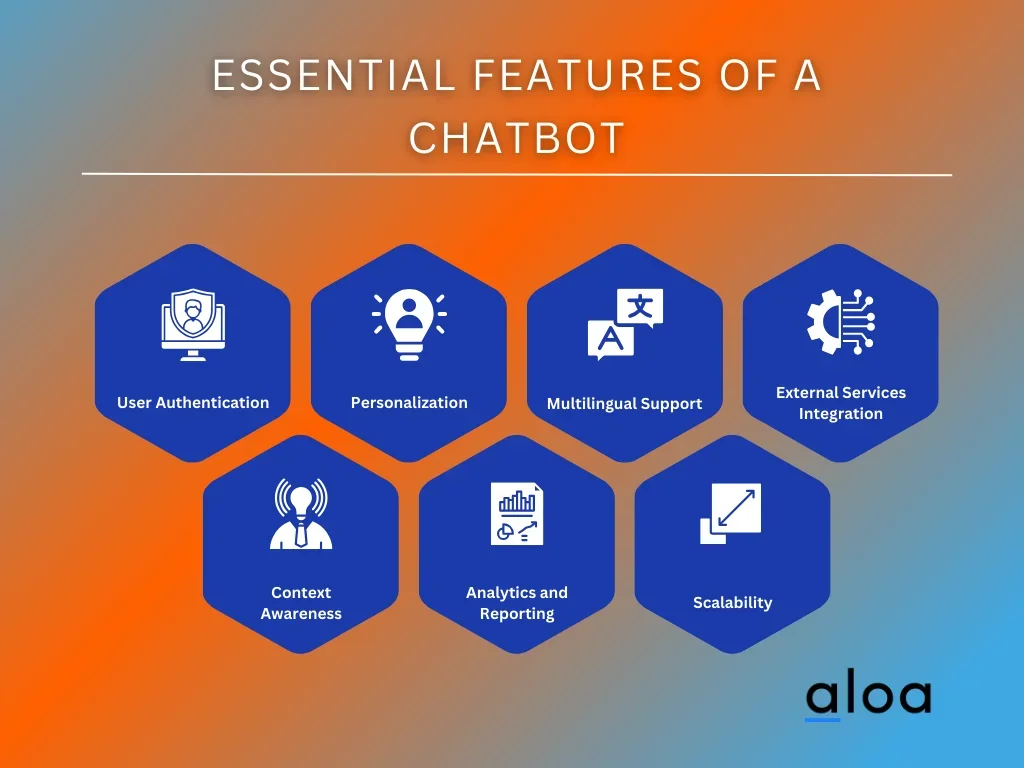
User Authentication
With the ability to store information from various users online, it's important that your chatbot is developed with safety and security in mind. The ability to secure user authentication can help prevent it from accidentally leaking sensitive information or performing personalized tasks intended for another developer or user.
Companies looking to integrate a chatbot within their system should take great care to develop fail-safes to ensure that private data remains secure in the system. Additional security features, such as locking specific keywords, can also prevent machine-learning chatbots from straying away from the intended code of ethics that a company correlates with.
Personalization
Personalizing user experience can promote chatbots to operate with a uniquely tailored "personality," which breathes more life into each conversation. Learning how to build a chatbot that can take user preferences, history, and behavior can help simplify personalization while minimizing the need for direct interference from software developers.
Multilingual Support
Software developers come from around the globe. Our team at Aloa hosts development companies from every corner of the world, which makes multilingual support an integral component of learning how to build a chatbot. Larger support for multiple languages can also cater to a more diverse user base.
Integration with External Services
Developers looking for a chatbot that can operate on other platforms or provide external services should consider integration services an essential feature to implement. Various APIs allow virtual assistant integration to help prevent users from needing to manually set up appointments, order items, or retrieve information online.
Context Awareness
Enabling a chatbot to have the capability to understand and maintain context, whether through machine learning or artificial intelligence, during a conversation can help solidify a coherent interaction experience for users. Developers will always have the potential to set their chatbots to use their developed context awareness to utilize the sent messages as part of their natural responses.
Analytics and Reporting
All software should integrate a method to analyze and send reports effectively to ensure that all system components operate smoothly. For chatbots, data analytics such as tracking user interactions, popular queries, chatbot performance, and response time are all critical information used to improve the bot's full capabilities.
Scalability
As chatbots become more accessible, it's essential to introduce scalability features to help handle a larger influx of user loads. The chatbot architecture can use data analytics to create a growing number of personalized responses. It can also simplify categorizing user feedback to help make better and more comprehensive interactions.
Teaching developers how to build a chatbot requires combining technical skills, creativity, and a deep understanding of user needs. Regular updates and improvements based on user feedback are crucial for ensuring the chatbot remains effective and valuable over time.
Building a Chatbot: Use Cases
Chatbots have a wide range of use cases across various industries, from healthcare to e-commerce. Here are some examples of how to create a chatbot for your business and how organizations can leverage chatbots:
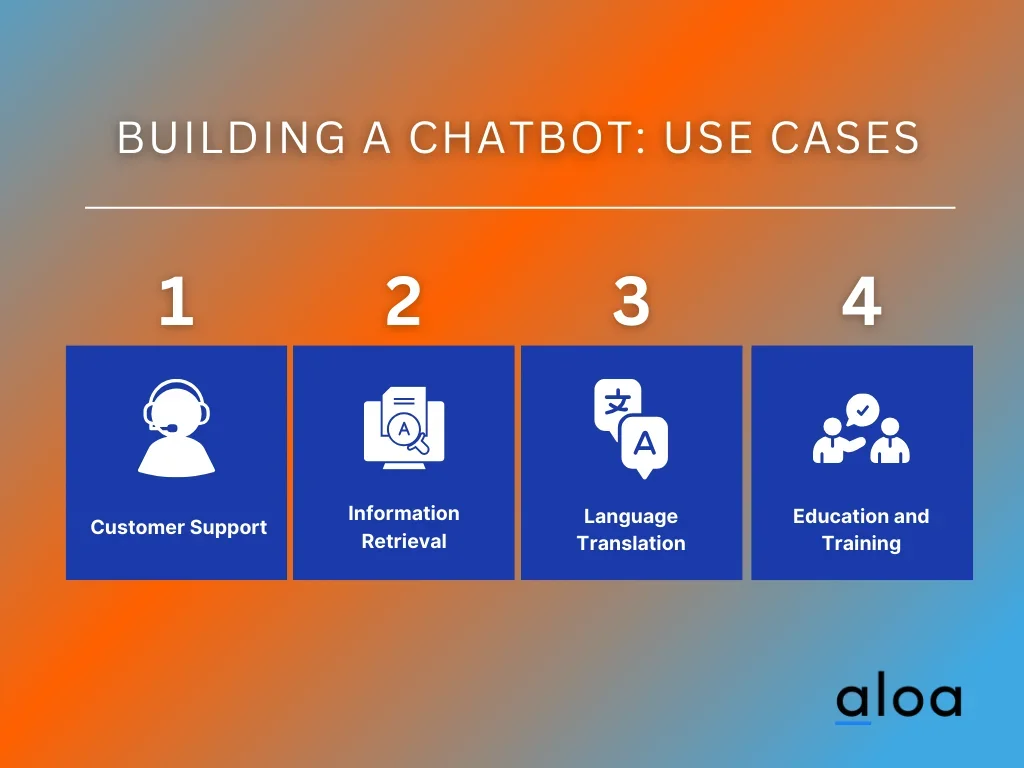
Customer Support
Communicating with customers and dealing with online services can become challenging for some users. Implementing a basic chatbot can help redirect their questions through the system and uses NLP to help distinguish the specific keyword to help guide users to a solution like Tidio's AI agent for customer service.
Information Retrieval
There is an overwhelmingly abundant amount of information available online. Directly communicating with a virtual assistant chatbot can simplify the information retrieval process and narrow the search to cater to your specific needs and preferences. User input and wording will also be calculated to help provide more accurate results.
Language Translation
Real-time language translation can help bridge the gap between nations and promote active communication. Multilingual support can also directly translate specific words or images by sending them through a complex chatbot system such as Google Translate to help users traveling to a foreign country.
Education and Training
Chatbots can assist users in formulating advanced formulas and breaking them down in an easy-to-understand format based on the information retrieved by your system. To improve the chatbot's ability to process and explain complex information, implement clustering text embeddings to group related concepts and provide more contextually relevant responses. Providing a specific personality module to a chatbot can also make the learning process easier and more engaging than reading through a simple text explanation.
Key Takeaway
Understanding how to build a chatbot can help integrate a new form of communication tool while minimizing the need to implement complicated structures to share information between users. Companies looking to integrate a chatbot service into their business can use this tool to establish a more personalized approach to customer support.
Surprisingly, virtual assistants can also be integrated with a chatbot system to perform various tasks, such as setting dates or making reservations. Each new technological development will only further improve the potential of chatbots and create a system that can function through one simple development platform.
Looking forward to building your customized chatbot tailored to your project and business needs? Contact us at [email protected] today and subscribe to our email list via our blog page to stay informed about the latest developments in advanced technologies. We'll deliver valuable content that keeps you ahead of the curve, empowering you to leverage the latest trends for increased profitability and business success through customized chatbots!

